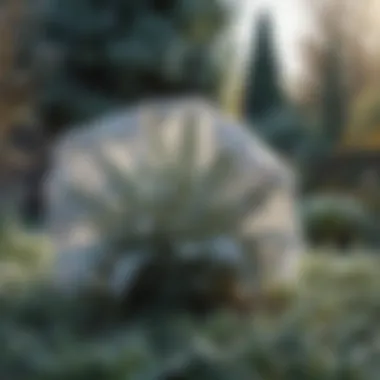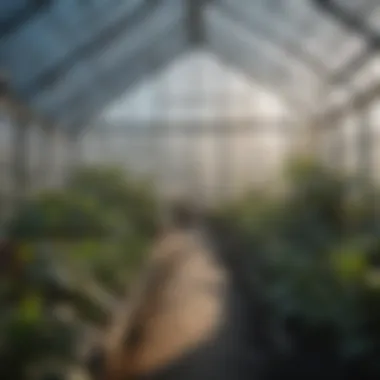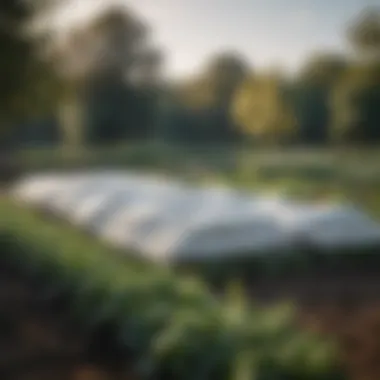Effective Strategies to Protect Your Plants from Frost


Intro
As the chill of winter creeps in, gardeners across the landscape face a common foe: frost. Understanding how frost forms and its potential impact on your plants is critical. Frost can freeze tender leaves and stem tissue, causing irreparable damage, and sometimes even leading to the demise of beloved flora. This article is here to arm you with a spectrum of strategies, materials, and techniques for safeguarding your plants against the bitter cold.
In essence, frost is a result of specific atmospheric conditions: cooling temperatures, humidity levels, and clear skies. When the temperature dips below 32 degrees Fahrenheit, dew on surfaces freezes, signaling a frost event. Different plants have varying levels of frost resistance, with some, like pansies, thriving in colder climates, while others, such as tomatoes, are quite delicate.
Understanding the nature of frost is just one piece of the puzzle. The real challenge lies in deciding how best to protect your precious plants. Whether you're tending to a sprawling garden or a few pot plants, there are numerous methods to cover and protect them from frost damage effectively. Let's dive into the world of design inspirations for that essential plant cover.
Understanding Frost and Its Impact
When it comes to caring for your plants, nothing quite hits home like the chill of frost. It’s essential to grasp why understanding frost and its implications are cornerstone topics for maintaining a thriving garden. The temperature dips come not just as a surprise but as a potential threat to your plants. The more you know about frost, the better equipped you’ll be to implement effective protection strategies.
Frost can wreak havoc on your garden, leading to weakened plants and compromised yield. By understanding how frost forms, you’re essentially gaining insight into nature’s timing. You can better prepare—and when you prepare, you reduce the risk of losing your beloved plants.
Key Points to Consider:
- Frost formation is influenced by several factors, like climate and geography, making it imperative to tailor your strategies to your local environment.
- Recognizing how frost impacts different plant varieties can directly inform what methods are best suited for safeguarding them.
- Understanding frost formation not only prepares you for immediate actions but also encourages a long-term perspective in your gardening practices.
"An ounce of prevention is worth a pound of cure." This proverb rings especially true in the context of frost protection. Knowing what’s at stake pushes the gardener to stay vigilant.
While protecting your plants may seem like a daunting task, possessing a solid foundation of knowledge can make the challenge manageable. Let’s break it down into bite-sized chunks that make this concept clearer.
What Is Frost?
Frost is essentially a thin layer of ice that forms on surfaces when the air temperature drops below freezing, typically 0°C or 32°F. It occurs under clear skies during the night when heat escapes into the atmosphere. As temperatures fall, moisture in the air condenses into tiny ice crystals on plants, soil, and other surfaces.
These icy crystals may look pretty in the morning sun, but they can be detrimental to tender plants. Their formation often signals that our attention is needed. Depending on your geographical locale, frost can hit quite early in the season—sometimes as early as late summer or fall, or linger into early spring—catching unprepared gardeners off guard.
Causes of Frost Formation
Frost formation is not an accidental affair; it’s influenced by an interplay of several climatic elements. Notably:
- Nighttime Cooling: When nighttime temperatures fall and skies are clear, heat radiates away from the earth's surface. This cooling is a primary factor behind frost.
- Humidity Levels: Moist air holds more heat than dry air. Consequently, low humidity can lead to quicker temperature drops, escalating the chances of frost.
- Terrain and Location: Areas at higher elevations, or those tucked away in valleys, can experience frost more readily than others. Cold air naturally flows into these low spots, setting the stage for frost.
Understanding these contributors to frost formation gives gardeners the foresight needed to anticipate potential frost events.
How Frost Affects Plants
The impact of frost on plants can range from minor damage to complete failure, depending on a variety of factors. With frost exposure:
- Cell Damage: The ice crystals that form within plant tissues can puncture cells, leading to irreversible damage. This can result in wilting or browning of leaves and stems.
- Stunted Growth: Even if a plant survives the initial frost, stress from the cold can lead to stunted growth and reduced flowering or fruiting capabilities.
- Susceptibility to Disease: Frost-damaged plants are more vulnerable to pathogens, which can thrive in environments where a plant is already stressed or weakened.
Clearly, the consequences of frost can be dire. A thoughtful and proactive approach can mitigate these challenges, ensuring that your garden not only survives but thrives during the colder months.
Timing Your Protection Strategies
Understanding when to implement protection measures for your plants is vital. Timing can be the linchpin in their survival against frost. In gardening, as in many arenas, it's not just about the 'what' but also the 'when' that influences success. Frost may be a common threat, yet its timing can vary significantly based on your location and the particular microclimates within your garden. Proper timing in your protection strategies can mean the difference between flourishing blooms and a patch of wilted leaves.
One key advantage in mastering timing is situational awareness. For instance, knowing the approximate last frost date in your area allows you to strategically time your planting and cover practices. A keen eye on the weather can also equip you with real-time adjustments needed to shield your plants effectively. These considerations are not trivial; they can drastically enhance your gardening experience by fostering healthier plants throughout the seasons.
Identifying Frost Dates in Your Area
To protect your plants effectively, knowing local frost dates is crucial. Local agricultural extensions or gardening websites can provide this data specific to your region, which might include the last spring frost and the first autumn frost dates.
Here are some easy steps to identify frost dates:
- Consult Local Resources: Extension services or local gardening clubs often publish frost date charts tailored to their regions.
- Utilize Technology: Weather apps and websites can give timely alerts for projected temperatures. Look for historical data as well—all that you need is a bit of research.
- Engage With Your Community: Local gardeners can offer anecdotal insights that can supplement your research.
A good practice is to mark these important dates on your calendar. Don't just rely on memory; this will serve as a constant reminder and could alert you to potentially hazardous cold snaps.


Monitoring Weather Conditions
Being vigilant about daily weather conditions is pivotal in implementing timely plant protection. Even if you know the typical frost dates, unexpected weather patterns can spring up, especially in transitional seasons like spring and fall.
- Check Daily Reports: Keep an eye on nightly forecasts. Temperature dips can happen overnight, even when daytime conditions seem mild.
- Adapt to Changes: Weather can be unpredictable. A forecast that suggests a warm week can shift. Be always prepared—keep your protective materials within reach.
- Consider Your Microclimate: Your garden may be influenced by nearby structures, trees, or elevation, often creating a different climate than officially recorded.
Adjusting your protective measures quickly based on the latest updates can make a massive difference.
Signs of Impending Frost
Sometimes, nature gives us subtle signs that frost is on the horizon. Recognizing these cues can help avoid last-minute scrambles.
- Temperature Drops: If temperatures dip significantly in the evening, it can signal frost is likely, even if the day was balmy.
- Calm Winds: A still night often brings a chill. Wind tends to mix air layers, reducing the chances of frost forming. A calm night can signal caution.
- High Humidity: Humidity is also a telltale; it can create conditions favorable for frost, particularly during clear nights.
- Heavy Dew: If dew forms heavily on grass and leaves, it could mean that temperatures are about to fall to frost levels.
Learning to read these indicators enhances your ability to react promptly, ensuring you have time to cover or protect your plants accordingly. Pay attention to nightly changes and adapt your strategies as needed.
"The best laid plans often go awry, but with timing, gardeners can proactively defend against frost damage."
Being aware of the frost timings, weather conditions, and nature's signs gives you the upper hand over frost's unpredictable behavior. Ultimately, timing your protective strategies can pave the way for a thriving garden even in the starkest of winters.
Materials for Covering Plants
When it comes down to shielding your beloved plants from frost, the choice of materials plays a pivotal role. Different materials offer varying levels of insulation and protection, enabling gardeners to implement the most effective strategies in the face of chilling temperatures. Choosing the right material not only helps in safeguarding the plants, but also actively contributes to overall plant health during the colder months.
With every option presented, there's a balance to strike between effectiveness and practicality. So, let’s delve into some prominent materials commonly utilized for plant protection.
Fabric Covers: Pros and Cons
Using fabric covers, such as row covers or frost blankets, is one of the most common methods for protecting plants from frost. These materials create a barrier against cold air while allowing light and moisture to reach the plants.
Pros:
- Breathability: Fabric allows for air circulation, which is beneficial for most plants.
- Lightweight: Easier to handle and manipulate than heavier materials.
- Reusable: Many fabric covers can be utilized year after year, making them cost-effective in the long run.
Cons:
- Limited Warmth: Generally, they can provide only a moderate level of insulation; extremely cold temperatures may penetrate.
- Wind Sensitivity: In strong winds, they might shift or even tear, leaving your plants vulnerable.
When opting for fabric covers, be mindful of the specific fabric’s weight. Different weights can offer varying degrees of frost protection, so selecting one that aligns with your local climate conditions is vital.
Plastic Sheeting: When to Use
Plastic sheeting presents a more robust option for frost protection. Its watertight nature can effectively trap warmth and regulate temperature beneath, making it a favorable choice in certain circumstances.
Use Cases:
- Severe Cold: If the forecast calls for plunging temperatures or extended frost periods, plastic sheeting might be the way to go.
- Temporary Greenhouses: Constructing makeshift greenhouses using plastic can provide a haven for your plants.
However, it's important to be cautious with plastic. In bright sunlight, it can trap heat to levels that may harm your plants. This is particularly true for delicate seedlings. Using this option requires frequent monitoring of the conditions under the cover, ensuring they remain conducive to plant health.
Mulch and Bedding: Natural Insulation
Now, let’s shift gears to some natural methods that can aid in protecting your plants. Mulch, be it wood chips, straw, or even leaves, provides a layer of insulation that can combat frost on the ground.
Benefits:
- Soil Temperature Regulation: Helps maintain consistent soil temperatures, mitigating sudden drops that can damage roots.
- Moisture Retention: Mulch can also help retain soil moisture, which becomes crucial in winter when plants might be more susceptible to drying out.
For perennial beds, consider mixing organic matter into the mulch. It not only adds nutrients over time but also provides a better blanket of protection against those freezing nights.


Other Creative Cover Options
Sometimes, unconventional materials may just do the trick in providing that much-needed protection. Think outside the box with these ideas:
- Old Bed Sheets or Towels: When in a pinch, using bed sheets can serve as a lightweight cover for individual plants or small areas.
- Cardboard Boxes: These can be placed over small plants, providing an insulating layer while being biodegradable.
- Cloche or Bell Jars: These can be used to cover individual tender plants, creating a mini greenhouse effect.
While these materials might not provide full conservation from the cold, they are accessible solutions that can be deployed without additional costs. Just keep an eye on the weather and remove the coverings when conditions improve, as suffocating plants under too much cover can harm them in the long run.
"Resilience in gardening often comes down to attention and adaptation. Take time to assess your unique environment and make informed choices about your plant protection strategies."
Techniques for Covering Plants
Understanding how to effectively cover your plants during frost is fundamental for any gardener aiming to safeguard their greens. Frost does more than just nip at the leaves; it can devastate budding flowers or freshly sprouted vegetables. With the right techniques, you can enhance your garden's resilience against cold temperatures. This section examines various covering methods, each with specific benefits and considerations that align with a thoughtful garden care strategy.
Direct Covering Techniques
Direct covering is a straightforward and often effective method to protect plants during frost. This involves using materials to physically shield your plants from icy conditions. Common options include cloths, blankets, or specifically designed frost covers. While these covers act as insulation, they also trap heat at night when temperatures drop. However, it's vital to remember that too much contact with the covers can cause damage to delicate foliage.
- Pros: Simple and easy to implement. Immediate protection against frost.
- Cons: Requires timely setup. Risk of damage if covers are too heavy or if moisture collects underneath.
To implement direct covering:
- Choose the Right Material: Lightweight fabrics are preferable, allowing for some ventilation while still providing insulation.
- Cover in Time: Aim to cover your plants before temperatures drop significantly during the evening.
- Secure the Covers: Ensure the covers are anchored so they don’t blow away with the wind.
Creating Microclimates
Microclimates can be like a warm hug for your plants during those chilly nights. By manipulating your garden's environment, you can create pockets of warmth where plants can thrive even when the air outside is frigid. This could involve using larger objects, like walls or fences, to block cold winds or planting in a way that maximizes sun exposure.
- Planting Against Structures: Plants placed near buildings can benefit from heat radiating from the walls.
- Use of Mulch: A protective layer of mulch can help retain soil warmth, insulating roots from the freezing air above.
"Creating a microclimate is about playing the long game. The more you know about your garden's layout, the better suited you'll be to design effective sanctuary spaces for your plants."
To cultivate microclimates effectively:
- Observe Wind Patterns: Take note of predominant wind directions and plant accordingly.
- Maximize Sunlight Exposure: Ensure that your plants get the morning sun, as it can significantly warm the soil.
Using Row Covers Effectively
Row covers can serve as both a shield and a blanket, ideally suited for covering entire rows of plants, particularly in vegetable gardens. These lightweight materials ease the worry of frost and can also protect against insects and harsh elements. They offer the added benefit of letting sunlight seep through, providing warmth without obstructing growth.
- Varieties Available: Some row covers are designed for frost only, while others offer additional UV protection. Choosing the right type is crucial for achieving the best outcomes.
- Thoughtful Placement: When using row covers, be sure to create a tent-like structure, allowing space for taller plants to grow without being crushed.
In summary, learning to use row covers effectively can provide immense benefits:
- Early Spring Planting: Row covers can help extend the growing season by protecting young plants in early spring.
- Ventilation Needs: Make sure to lift the covers on warm days to allow air circulation, preventing overheating.
With these techniques at your disposal, you'll be better equipped to ensure your plants thrive despite the chilly onslaught of frost. Keeping these strategies in mind will enhance your garden's ability to weather the storm.
Protecting Specific Types of Plants
When it comes to shielding plants from frost, understanding the specific needs of different types of vegetation is paramount. Each plant category—annuals, perennials, vegetables, shrubs, and trees—has its quirks and requirements for frost protection. This tailored approach ensures that strategies maximize the benefits for each plant type, allowing you to foster a thriving garden even in the cold.
Annuals: Short-Term Strategies
Annuals are often the first casualties of frost. These plants complete their life cycle in one growing season, making them particularly sensitive to sudden drops in temperature. To protect these vulnerable beauties, consider these key practices:
- Covering with Cloches: Simple glass or plastic bell jars can create an instant greenhouse effect for individual plants. Ensure they are anchored to the ground to prevent them from blowing away.
- Row Covers: Lightweight fabric can be draped over rows of annuals. It allows light and moisture through while maintaining warmth.
- Temporary Heat Sources: On particularly frigid nights, placing battery-operated lights or heat mats near the plants can offer a little extra warmth.
These methods provide immediate, short-term intentions, letting annuals survive until the temperatures recover.


Perennials: Long-Term Considerations
Perennials, unlike annuals, persist year after year, which makes their long-term survival strategies more critical. Preparation starts with choosing the right varieties for your climate. Here are some steps to consider for perennial protection:
- Mulching: Applying a thick layer of organic mulch helps insulate roots. Straw, shredded leaves, or bark can be effective materials.
- Pruning Wisely: Cutting back perennials in the fall allows better exposure to frost protection methods later on. Only prune certain plants that benefit from it.
- Plant Positioning: Positioning perennials in sheltered spots, like against a wall or a fence, can mitigate wind exposure and provide some heat.
These techniques not only protect plants during frosty nights but also promote overall health and growth throughout the seasons.
Vegetable Gardens: Key Tips
Vegetables present their own set of challenges during frost. Some crops are hardier than others, but all need thoughtful strategies to ensure a bountiful harvest. Consider the following:
- Hardy Varieties: Choose varieties that withstand frost well, such as kale or Brussels sprouts.
- Tunnel Covers: Building temporary greenhouses using PVC pipe and plastic sheeting can protect entire rows of vegetables.
- Cover Cropping: Planting cover crops like winter rye in the offseason can improve soil health and moisture retention, supporting your vegetable garden through colder months.
Protecting your vegetable patch takes diligence, yet these strategies can keep your edible garden thriving when temperatures dip.
Shrubs and Trees: Special Measures
Shrubs and trees require a more nuanced approach to frost protection due to their longevity and size. A few notable practices include:
- Wraps and Burlap: Wrapping the trunks of smaller trees or young shrubs in burlap can shield them from freezing temperatures. This is particularly true for newly planted materials.
- Protecting Roots: For established trees, adding mulch to around the base helps insulate roots. Just avoid piling it against the trunk to prevent rot.
- Monitoring Location: Be mindful of where your trees and shrubs are planted. Avoid exposed locations where wind can whip through and cause additional chill.
In essence, protecting these larger plants requires foresight and proactive measures to ensure they can weather the cold months effectively.
"Understanding the unique needs of diverse plant types empowers you to take specific, meaningful actions that can safeguard your garden against frost damage."
By tailoring each frost protection strategy to the type of plant it supports, you'll be much better equipped to nurture resilient growth in your garden, no matter how low the temperatures drop.
Post-Frost Care for Plants
Taking care of plants after a frost is as crucial as the protective measures employed beforehand. A frost can be a real game-changer, impacting your plants' health and vigor. Not all plants recover equally, and how you respond post-frost can significantly influence their recovery and growth prospects. Here’s a close look at how to navigate the after-effects of frost for optimal plant health.
Assessing Damage
Once the frost has passed, assessing how it has affected your plants is the first step. Look closely at the leaves and stems. Signs of frost damage may include brown spots or a wilting appearance. Tender leaves are particularly sensitive; if they feel mushy or have turned black, they might be beyond saving.
A handy trick: gently snap a stem. If it breaks easily, it may be dead. Conversely, if it bends but does not break, your plant might still have some life left in it. Take notes on each plant's condition as this helps you track damage across seasons and determine specific care needs going forward.
Recovering Plants: Best Practices
Once you’ve assessed the damage, it’s time to initiate recovery. Here are steps to help your plants bounce back:
- Prune Damaged Parts: Cut away any dead or severely damaged foliage. This action helps the plant redirect its energy to healthier areas. Pruning also improves airflow, reducing the risk of fungal infections.
- Water Wisely: After a frost, plants may be a bit dehydrated. However, avoid overwatering as roots can rot if they sit in waterlogged soil. Give a good soak when the soil feels dry about an inch down.
- Fertilize Sparingly: Right after a frost is not the best time to apply fertilizers. Hold off for a bit until you see signs of new growth.
"Frost doesn’t just chill the air; it can chill the spirit of a gardener. But with care and attention, recovery is possible."
Long-Term Maintenance After Frost
The post-frost period is a golden opportunity to strengthen your plants against future frost events.
- Mulching: Apply a layer of mulch around the base of each plant. This acts as insulation, helping regulate root temperature and retaining moisture. Organic mulches can also contribute nutrients as they break down over time.
- Observe & Adapt: Keep an eye on how your plants respond in the weeks following the frost. Adjust watering and light exposure based on their needs.
- Plan Ahead: Take notes regarding what worked or didn’t work post-frost year after year. Research the best varieties for your climate zone, focusing on frost-resistant plants. Knowing when to cover and uncover your plants can make all the difference.
Ultimately, a proactive and thoughtful approach to post-frost care can significantly enhance the health and resilience of your garden. Regular attentiveness ensures that your plants don’t just survive but thrive.
For more in-depth information, consider checking out resources like Wikipedia, Britannica, or engaging with fellow gardeners on platforms like Reddit for practical insights.
Ending
In summary, understanding how to protect your plants from frost is essential for any gardener who wishes to maintain a vibrant and healthy garden. Frost, while a natural phenomenon, can wreak havoc on tender foliage and impede growth if proper precautions aren't taken. This article has dissected various elements of frost protection, emphasizing the significance of timing, appropriate materials, and various techniques tailored to different plant types.
Key Takeaways
- Know Your Frost Dates: Identifying local frost dates can drastically improve preparedness. With this knowledge, gardeners can implement cover strategies just in the nick of time, potentially saving their plants from frostbite.
- Material Matters: Different covering materials serve different purposes. For instance, row covers can offer lightweight protection, while plastic sheeting may trap heat effectively but could also cause humidity problems if not used correctly. Always consider the specific needs of your plants when selecting materials.
- Monitor Weather Conditions: Being attuned to changing weather patterns is crucial. Apps and local weather reports can offer forecasts that help anticipate frost and take action accordingly.
Final Thoughts on Frost Protection
Protecting your plants during frost is not merely a reactive measure but a proactive one. It involves engaging with the rhythms of nature, keeping a close eye on budding signs that could indicate frost, and taking action to mitigate potential damage. Developing strategies for distinct types of plants, whether they are exuberant annuals or robust perennials, allows for a more nuanced approach to frost prevention. The wealth of knowledge gathered here aids in creating a resilient garden that can endure cold spells, and it empowers the dedicated gardener to make informed decisions to nurture their beloved plants year-round. Remember, it’s not just about saving your plants; it's about enabling them to thrive through seasonal shifts.







